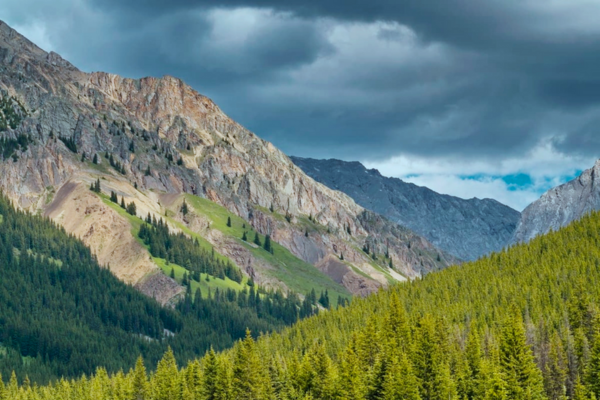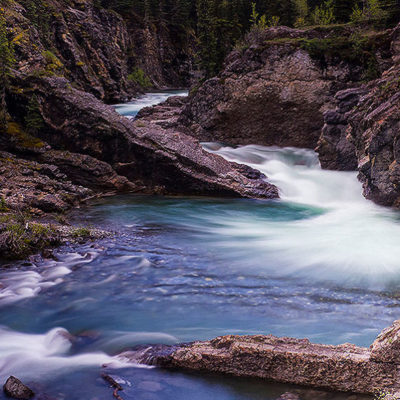Premier Peter Lougheed officially dedicated Kananaskis Country and Kananaskis Provincial Park in 1978; the park was renamed in 1986 to honour Peter Lougheed when he retired as premier. The story of Kananaskis Country and the effort to preserve it began much earlier and continued long after the region’s formal establishment.
The Dominion Lands Act of 1872 was the original authority for future parks in present-day Alberta. It granted rights of way to the national railway system, gave lands in Western Canada to colonizers, and set aside land for First Nations reserves and future parks. In what became southern Alberta, these had been the traditional lands of the Stoney-Nakoda, Kootenai, Siksika, Kainai, Peigan, and Tsuut’ina nations.
The first park in Alberta extended from north of Jasper to as far south as Lake Louise, and was a result of the Rocky Mountain Park Act of 1887. When that legislation was replaced by the Dominion Reserves and Parks Act in 1911, reserved lands were reduced by more than half. The Natural Resources Transfer Agreement of 1929, and the resulting National Parks Act of 1930, removed areas to the east and south of Banff that were of potential commercial value. This included much of today’s Kananaskis Country and Peter Lougheed Provincial Park. These lands were turned over to the Alberta government and became provincial public lands. That same year, the provincial government passed the Provincial Parks and Protected Areas Act, and the first provincial parks were created in 1932. But it took another half-century before Kananaskis received such recognition.
Kananaskis was always a mixed-use area, made accessible by roads that facilitated extraction of coal and minerals for construction and industry. It had also been used for natural gas and hydroelectric production. Work camps built in the 1930s provided forestry work for single young men during the Great Depression. During the Second World War, the camp was used first as an internment camp for civilian internees and later for prisoners of war, closing in 1946.
In 1977, Premier Lougheed’s cabinet approved the creation of the Kananaskis Planning Area (Kananaskis Country) a 4,160 kilometre tract of land southwest of Calgary. Kananaskis Provincial Park was included in Kananaskis Country. The first few years of policy around Kananaskis centred on development, chiefly roads and utilities, hotels, a golf course, and small, privately-owned alpine villages.
An encouraging step toward conservation took place nearly a decade later. In 1986, the province approved the Kananaskis Country subregional Integrated Resource Plan (IRP). The plan’s management objectives outlined that the development and utilization of resources in the planning area “occur in a manner consistent with the principles of conservation and environmental protection.” The focus had shifted to management of resources, including watersheds, wildlife, fish, grazing lands, minerals, heritage, and forestry. But there was still no clear plan for the future of Kananaskis, and pressure from commercial developers continued.
In 1992, Three Sisters Resorts proposed a development at Wind Valley, which is part of a critical wildlife corridor between Banff National Park and Kananaskis Country. The Natural Resources Conservation Board (NRCB) held hearings on the proposal, and CPAWS Southern Alberta, the Sierra Club, and the Alpine Club of Canada were granted intervenor status. People opposed to the development could purchase “Keep the Wind Valley Wild” t-shirts and attend the “Wind Valley Wind-dig” fundraising event. During the hearings, two deficiencies in the developers’ Environmental Impact Assessment were identified; the negative impact on large mammals, and the fact that Wind Valley had previously been set aside as mitigation for development in Kananaskis Country. The NRCB ruled in CPAWS’ favour, and the provincial cabinet endorsed the ruling in late December, 1992. The Alberta government ensured protection of Wind Valley through special places designation in March, 1994.
Increased pressures on the area led to attempts to assess public opinion on future development and use of Kananaskis Country. A 1996 poll conducted by the government showed public opposition to further commercial development in the area. Another poll, done by CPAWS Southern Alberta and other conservation organizations, supported these results, as did yet another poll done by the Calgary Herald. Instead of accepting these results, Environmental Protection Minister Ty Lund launched a new survey asking for public input on appropriate levels of future development and issues relevant to the Spray and Kananaskis valleys.
Kananaskis Country was facing numerous applications for commercial development and increasing pressures from a growing urban population. At the same time, it was still being administered with an outdated recreation policy and an outdated IRP. CPAWS SAB and other like-minded organizations wanted to clearly establish the future of Kananaskis Country, and they continued to engage the provincial government on key areas that should be conserved. The establishment in 1998 of the Elbow-Sheep Wildlands and Bow Valley Wildlands was cause for celebration.
CPAWS SAB became involved with the development of the Kananaskis Recreation Development Policy, including making recommendations to the Minister of Environmental Protection, preparing a statement and encouraging attendance at public meetings. The final recommendations were presented to the minister at the end of January, 1999, but release to the public was delayed until policy decisions were made. By the summer of 1999, CPAWS Southern Alberta and its supporters were relieved to find that there would be no new recreation developments in Kananaskis, and that existing proposals would be subject to stringent environmental reviews.
A large recreation facility was still being proposed for the Spray Valley in the spring of 2000 when Environment Minister Gary Mar announced the creation of Spray Valley Provincial Park, increasing protection for the area and canceling the proposed development. This 358 square kilometre park connected Peter Lougheed Provincial Park to Bow Valley Wildland Provincial Park.
In 2001, the provincial government announced three new provincial parks in Kananaskis; Sheep River, Bluerock Wildland, and Don Getty Wildland, which added more lands to the network of protected areas in the Rocky Mountains. Spray Valley and Bow Valley Wildland Provincial Parks were expanded in 2004 as part of the Evan Thomson Provincial Recreation Plan.
The government heeded public outcry to end commercial development in Kananaskis, and CPAWS Southern Alberta and all our supporters celebrated this hard-fought success. CPAWS Southern Alberta continues to offer input into regional plans in Southern Alberta, ensuring that management plans continue to hold conservation and environmental protection at their core. The Kananaskis landscape was changed drastically in 2013 as a result of unprecedented flooding, but during the course of rebuilding the structures, the ecological integrity of the area has remained intact.
Kananaskis would look very different than it does today if it hadn’t been for the work of CPAWS Southern Alberta and our many colleagues and supporters. Thankfully this beautiful, natural, wilderness recreation area will be protected for future generations to enjoy.
Kirsten Olson
Office and Fund Administrator
CPAWS Southern Alberta
More News

All-Seasons Resort Policy Released

Critical Habitat and Industry Lobbying Part 4: How DFO Allows Critical Habitat Destruction


